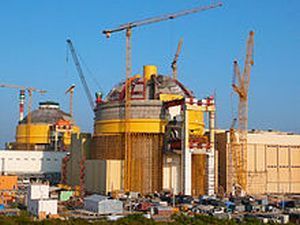
Publisher:
Bonnie King
CONTACT:
Newsroom@Salem-news.com
Advertising:
Adsales@Salem-news.com

~Truth~
~Justice~
~Peace~
TJP
Aug-23-2012 21:28

 TweetFollow @OregonNews
TweetFollow @OregonNews
Kundakulum: Questioning India's Capability To Guarantee Nuclear Safety Analysis
Shubhra Chaturvedi Special to Salem-News.comIs India's technologically capable as well as stable to prosper as a responsible nuclear power?
 Kudankulam Atomic Power Project |
(NEW DELHI) - The sudden re-emergence of a hue and cry (http://bit.ly/O3FwOM) in the Sri Lankan media regarding radiation emitted by the India nuclear plant at Kudankulam could not capture much attention around the world. The news however did raise certain issues especially in view of the incidents of tritium leakage in India. Do these reports hold any water? Is the raising of this issue genuine and why now? Are we capable of ensuring and guaranteeing nuclear safety?
Media coverage
The Island published a piece in which India was accused of being ignorant of its neighbourhood and of international law in view of the radiation emitted by the nuclear plant at Kudankulam. Indian experts see it as the raking up of an old, dormant issue. The reasons for the re-emergence of the concern can be many. The reports hint at India's irresponsible behaviour by talking about ‘Agni terrorism’ and linking it to environmental negligence (due to lack of information) and basic survivability concerns in Sri Lanka. Indian experts however differ.
Prof L V Krishnan says that ‘When both neighbours have operating nuclear reactors or are planning to build them, there is less of a scope for differences. Both India and Pakistan have nuclear power stations; Sri Lanka and Bangladesh in South Asia have plans for nuclear power stations. It is therefore unlikely that the governments in these countries would raise objections to the neighbour’s nuclear power stations’. The reports are therefore seen as an extension of insecurity and not necessarily a cry for safety.
He also says that ‘The fact is India’s plans to build reactors in Kudankulam were well known to the world including Sri Lanka for over two decades. It can be rightly argued that the Japanese experience in Fukushima has now triggered concerns in Sri Lanka’. While the reports could be a result of the fear that the Fukushima incident has inculcated in the minds of many, Prof R Rajaraman sees it more as a combination of an exaggerated fear, confusions that exist in the underatnding of nuclear technology and a political retaliation to the Indian vote against Sri Lanka at Geneva. While Prof Rajaraman claimed that normal functional reactors do have some degree of radiation he also argued that if the radiation would have been hazardous in Kudankulam, one would have heard much more about it.
International responsibility vs domestic responsibility
There is a general understanding that reactors undergo a long process of analysis by experts in the field, and the consequences of anticipated failures of safety systems are kept in mind during such analyses. It is true that radiation might occur due to several causes ranging from the ageing of the components to the operator’s errors, natural hazards and so on. According to Prof L V Krishnan, the regulatory body stipulates limits to the radiation dose that population may receive if such failures do indeed occur. It requires the plant to make adequate provisions in the design so as not to exceed these limits. These limits are generally in the same range as what is found to prevail in nature in many parts of the world with no perceptible adverse consequence to the people living in the area.
However, recent reports of the leakage at the Rajasthan Atomic Power Station (RAPS) at Rawatbhata near Kota, which exposed workers to tritium radiation raises questions about the effectiveness of the regulatory mechanism. The Hindu (http://bit.ly/SSfYaP) reported that four maintenance workers were exposed to tritium radiation on 19 July 2012 while repairing a faulty pipe in pressurised heavy water reactor (PHWR) Unit 4. The leakage was not the first of its kind – it had had also occurred on 23 June, when reportedly more than 40 persons working on a coolant at Unit 6 were exposed to tritium. The authorities claim that everything is normal and under control and that tritium is harmless. Though tritium is not highly dangerous, it is mildly radioactive and its ingestion can be problematic.
The right to develop nuclear power plants can very well be defended, and charges of negligence can be categorised as an over-reaction that cashes in on the politics of India’s projection as a responsible nuclear power. However, the question remains, is India technologically capable as well as stable to prosper as a responsible nuclear power? Nuclear technology is no more a threshold to cross for India as it was post independence. While the re-emergence of concern in the media about the dangers of Kudankulam may not be as strong as they are made out to be, the leakage on two different occasions does lend itself strongly to the aforementioned concerns. It is essential to link the two and ask whether the hue and cry is merely to paint India in a negative light.
Shubhra Chaturvedi Research Intern, IPCS email: shubhra@ipcs.org
First published by Eurasia Review News & Anaysis
 |
 |
 |
 |
 |
 |
 |
Articles for August 22, 2012 | Articles for August 23, 2012 | Articles for August 24, 2012

googlec507860f6901db00.html
Salem-News.com:


Quick Links
DINING
Willamette UniversityGoudy Commons Cafe
Dine on the Queen
Willamette Queen Sternwheeler
MUST SEE SALEM
Oregon Capitol ToursCapitol History Gateway
Willamette River Ride
Willamette Queen Sternwheeler
Historic Home Tours:
Deepwood Museum
The Bush House
Gaiety Hollow Garden
AUCTIONS - APPRAISALS
Auction Masters & AppraisalsCONSTRUCTION SERVICES
Roofing and ContractingSheridan, Ore.
ONLINE SHOPPING
Special Occasion DressesAdvertise with Salem-News
Contact:AdSales@Salem-News.com
Terms of Service | Privacy Policy
All comments and messages are approved by people and self promotional links or unacceptable comments are denied.
[Return to Top]
©2025 Salem-News.com. All opinions expressed in this article are those of the author and do not necessarily reflect those of Salem-News.com.